Home | Category: Language and Hieroglyphics
ANCIENT EGYPTIAN WRITING AND HIEROGLYPHICS
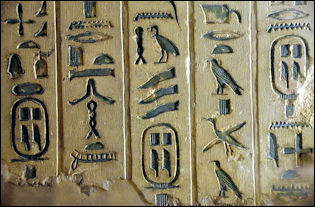
pyramid texts The Egyptians were one of the earliest people to develop a writing system. Their writing system was totally different from the one we use today. Instead of letters in an alphabet they used pictures and symbols that we call “hieroglyphics.” The word “ Hieroglyph” is Greek for "sacred writing." This a reference to the fact that the ancient Egyptians believed that the knowledge of writing was something that was bestowed from Thoth, the God of Knowledge.
The Egyptians also used “ hieriatic” writing (a cursive form) and “ demotic” writing (a cursive form that could be written very quickly). They were written mostly on papyrus and were used mainly for private and business correspondence. The symbols were abbreviated hieroglyphics.
The ancient Egyptians used hieratic written with ink and on papyrus paper for everyday communication, and for things like composing poems and stories, producing memoirs and wills and writing documents and personal letters. Although hieratic was easier to use theycontinued to use hieroglyphic pictures in their original forms. To make black ink they mixed vegetable gum, soot and bee wax. They replaced soot with other materials such as ochre to make various colours. [Source: Mark Millmore, discoveringegypt.com discoveringegypt.com]
Ancient Egypt writing-and also reading-was a professional rather than a general skill. Being a scribe was an honorable profession. Professional scribes prepared a wide range of documents, oversaw administrative matters and performed other essential duties.
Categories with related articles in this website: Ancient Egyptian History (32 articles) factsanddetails.com; Ancient Egyptian Religion (24 articles) factsanddetails.com; Ancient Egyptian Life and Culture (36 articles) factsanddetails.com; Ancient Egyptian Government, Infrastructure and Economics (24 articles) factsanddetails.com
Websites on Ancient Egypt: UCLA Encyclopedia of Egyptology, escholarship.org ; Internet Ancient History Sourcebook: Egypt sourcebooks.fordham.edu ; Discovering Egypt discoveringegypt.com; BBC History: Egyptians bbc.co.uk/history/ancient/egyptians ; Ancient History Encyclopedia on Egypt ancient.eu/egypt; Digital Egypt for Universities. Scholarly treatment with broad coverage and cross references (internal and external). Artifacts used extensively to illustrate topics. ucl.ac.uk/museums-static/digitalegypt ; British Museum: Ancient Egypt ancientegypt.co.uk; Egypt’s Golden Empire pbs.org/empires/egypt; Metropolitan Museum of Art www.metmuseum.org ; Oriental Institute Ancient Egypt (Egypt and Sudan) Projects ; Egyptian Antiquities at the Louvre in Paris louvre.fr/en/departments/egyptian-antiquities; KMT: A Modern Journal of Ancient Egypt kmtjournal.com; Ancient Egypt Magazine ancientegyptmagazine.co.uk; Egypt Exploration Society ees.ac.uk ; Amarna Project amarnaproject.com; Egyptian Study Society, Denver egyptianstudysociety.com; The Ancient Egypt Site ancient-egypt.org; Abzu: Guide to Resources for the Study of the Ancient Near East etana.org; Egyptology Resources fitzmuseum.cam.ac.uk
Book: “ The Story of Writing: Alphabets, Hieroglyphs & Pictograms” by Andrew Robinson
Hieroglyphics
Egyptian writing in the form hieroglyphics is associated most with inscriptions and writing on tomb and temple walls. Hieroglyphics function as both logograms (signs representing things or ideas) and phonograms (pictured objects represented sounds, similar to letters in an alphabet). They also served as word-signs (signs which stood for entire words) and syllabic signs (signs which stood for syllables). In Egyptian times syllables were not grouped into a single word as they are in English today. They were written separately as were words and thus sometimes distinguishing between a word and a syllable of a word was difficult. There were no hieroglyphic vowels.

Hierogliphics Stela of Nemtiui Hieroglyphics primarily represented the formal and ceremonial language for the pharaohs. They appeared on everything: paintings, obelisks, temple walls, coffins, tombs, documents, perfume containers. An estimated one third of the 110,000 Egyptian pieces in the British Museum have writing on them.
Simon Singh of the BBC wrote: “Hieroglyphs dominated the landscape of the Egyptian civilisation. These elaborate symbols were ideal for inscriptions on the walls of majestic temples and monuments, and indeed the Greek word hieroglyphica means 'sacred carvings', but they were too fussy for day-to-day scribbling, so other scripts were evolved in Egypt in parallel. These were the 'hieratic' and 'demotic' scripts, which can crudely be thought of as merely different fonts of the hieroglyphic alphabet. [Source: Simon Singh, BBC, February 17, 2011 |::|]
Mark Millmore wrote in discoveringegypt.com: “Hieroglyphs were called, by the Egyptians, “the words of God” and unlike the simple elegance of modern writing systems, this early attempt at recording words, used a number of techniques to convey meaning. The picture symbols represent a combination of alphabet and syllabic sounds together with images that determine or clarify meaning and depictions of actual objects which are the spoken word of the thing they represent. [Source: Mark Millmore, discoveringegypt.com discoveringegypt.com ^^^]
“All writing systems probably evolved in this way but their original forms were lost as pictures were refined to a simple abstraction making writing an efficient tool for day to day business. Indeed, the ancient Egyptian Hieratic script served this function but the Egyptians deliberately preserved Hieroglyphs, in their original forms, because they believed them a gift from the gods which possessed magical powers. So they inscribed them on temple walls, tombs, objects, jewellery and magical papyri to impart supernatural power not for mundane day to day communication. ^^^
“The script was developed about four thousand years before Christ and there was also a decimal system of numeration up to a million. Unlike other cultures the early picture forms were never discarded or simplified probably because they are so very lovely to look at. Hieroglyphs were called, by the Egyptians, “the words of God” and were used mainly by the priests. These painstakingly drawn symbols were great for decorating the walls of temples but for conducting day to day business there was another script, known as hieratic This was a handwriting in which the picture signs were abbreviated to the point of abstraction. ^^^
Reading Hieroglyphics
Hieroglyphic symbols are pleasing to the eye but difficult to understand. They also took scribes a lot of effort to make. Texts written with them are generally tedious religious hymns, tomb wall inscriptions, or lists of a rulers achievements. Texts written on papyri in hieratic — a less time-consuming cursive writing used by pharaohs alongside cursive hieroglyphs and primarily written in ink with a reed brush on papyrus — are often much more interesting.
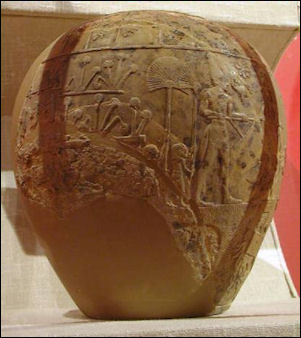
scorpion mace Mark Millmore wrote in discoveringegypt.com: “Hieroglyphs are written in rows or columns and can be read from left to right or from right to left. You can distinguish the direction in which the text is to be read because the human or animal figures always face towards the beginning of the line. Also the upper symbols are read before the lower. Alphabetic signs represent a single sound. Unfortunately the Egyptians took most vowels for granted and did not represent such as ‘e’ or ‘v’. So we may never know how the words were formed. [Source: Mark Millmore, discoveringegypt.com discoveringegypt.com ^^^]
“Syllabic signs represent a combination of two or three consonants. Word-signs are pictures of objects used as the words for those objects. they are followed by an upright stroke, to indicate that the word is complete in one sign. A determinative is a picture of an object which helps the reader. For example; if a word expressed an abstract idea, a picture of a roll of papyrus tied up and sealed was included to show that the meaning of the word could be expressed in writing although not pictorially. ^^^
“Ancient Egyptian history covers a continuous period of over three thousand years. To put this in perspective – most modern countries count their histories in hundreds of years. Only modern China can come anywhere near this in terms of historical continuity. Egyptian culture declined and disappeared nearly two thousand years ago. The last vestiges of the living culture ceased to exist in AD 391 when the Byzantine Emperor Theodosius I closed all pagan temples throughout the Roman Empire.
World's Oldest Writing
In 1995, John Coleman Darnell, a Yale Egyptologist, and his students discovered 18-x-20-inch tableau, dated to 3250 B.C., on a limestone cliff at a site called Gebel Tjauti, about 20 miles northwest of Luxor, that contains some line drawings of animals that are believed to be a record of the exploits of an Egyptian ruler. Because an image of a scorpion is present links to the Scorpion king were made. Some have even gone as far as calling the tableau “world’s oldest historical record” and claim the images are early hieroglyphics and are examples of the world’s oldest writing.
The tableau, probably incised with flint tools, has images of a scorpion, a falcon, large antelope, a bird, a serpent, a figure carrying a staff, a sedan chair, a bull’s head, a captor and captive. No one knows what the images mean. The link to the Scorpion King are based on the fact that the scorpion is near the falcon and falcons in ancient Egypt were associated with the god Horus and the pharaohs.
Some of the earliest writing was done on perishable papyrus. Much of has this been lost to time. The earliest Egyptian hieroglyphics are among the written languages that have not been deciphered. Others include are the Minoan language of Crete; the pre-Roman writing from the Iberian tribes of Spain; Sinaitic, believed to be a precursor of Hebrew; Futhark runes from Scandinavia; Elamite from Iran; Mohenjo-Dam, the language of the ancient Indus River culture; and Archaic Sumerian, the earliest written language in the world."
Cuneiform and Mesopotamian Writing
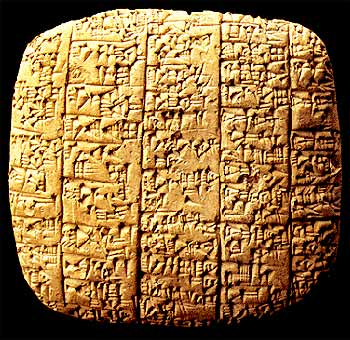
Mesopotamian writing Around 2,500 B.C., Sumerian writing evolved into partial syllabic script known as cuneiform capable of recording the vernacular. Each cuneiform sign consists of one or more wedge-shaped impressions that are made with three basic marks: a triangle, a line or curbed lines made with dashes.
Cuneiform (Latin for "wedge shaped") appears on baked clay or mud tablets that range in color from bone white to chocolate to charcoal. Clay tablets with pictographs appeared around 4000 B.C. The earliest with Sumerian writing appeared around 3200 B.C. Inscriptions were also made on pots and bricks.
Cuneiform symbols were made by scribes who used a stylus — with a triangular tip cut from reed — to make impressions on damp clay. The reeds could make straight lines and triangles but could not easily make curved lines. Different characters were made by superimposing identical triangles in different combinations. Complex characters had around 13 triangles. The moistened tablets were left to dry in the hot sun. After archaeologists excavate the tablets they are carefully cleaned and baked for preservation. The process is expensive and slow.
Many cuneiform tablets are dated by the year, month and day. Tablets from monarchs, ministers and other important people were impressed with their seal, which was applied on the wet clay like a paint roller with a cylinder seal. Some cylinder seals produced reliefs that were quite elaborate, made up of scores of images and markings. Important messages were encased in an "envelope" of more clay to insure privacy.
Cuneiform was used by speakers of 15 languages over 3,000 years. The Sumerians, Babylonians and Eblaites had large libraries of clay tablets. The Elbaites wrote in columns and used both sides of the tablets. The latest datable tablet, from Babylon, described the planetary positions for A.D. 74-75.
Oldest Names and Alphabet
The world's oldest surviving personal name is a king represented by the hieroglyphic sign of a scorpion on a Upper Egypt tablet from 3,050 B.C. Some scholars have suggested that the king's name was Sekhen.
In the second millennium B.C. Semitic tribes converted Egyptian hieroglyphics into the first alphabet. Some graffiti with letters, dated to around 1800 B.C., found in southern Egypt, has been offered as evidence of the first alphabetic writing. The graffiti was dated based on nearby hieroglyphics and is theorized to have been made by an ancient Semitic people. What the symbols mean is not clear and whether there are indeed alphabetic letters is a matter of some debate. They predate other examples of alphabetic writing by two centuries.
Evolution of Writing
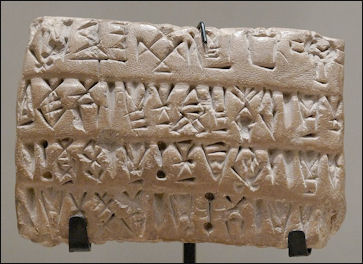
early Mesopotamian writing The 2010 exhibition “Visible Language: Inventions of Writing in the Ancient Middle East and Beyond,” hosted by the University of Chicago’s Oriental Institute, The show demonstrates that, contrary to the long-held belief that writing spread from east to west, Sumerian cuneiform and its derivatives and Egyptian hieroglyphics evolved separately from each another. And those writing systems were but two of the ancient forms of writing that evolved independently. Over a span of two millenniums, two other powerful civilizations — the Chinese and Mayans — also identified and met a need for written communication. Writing came to China as early as around 1200 B.C. and to the Maya in Mesoamerica long before A.D. 500. “It was the first true information revolution,” the Oriental Institute’s director, Gil J. Stein told the New York Times. “By putting spoken language into material form, people could for the first time store and transmit it across time and space.”[Source: Geraldine Fabrikant. New York Times, October 19, 2010]
Geraldine Fabrikant wrote in the New York Times, “Until the 1950s experts had believed that the Sumerians influenced the Egyptians, spreading the use of writing westward. But in the 1950s Günther Dryer, a German archaeologist, found writing on bone and ivory tags in an elaborate, probably royal burial site at Abydos in southern Egypt. The depth at which they were buried and subsequent carbon tests proved the pieces to be as old as Sumerian works. Because the marks were different in style, scholars believe that the Egyptians developed their own writing system independently.
Experts are still struggling to understand just how writing evolved, but one theory, laid out at the Oriental Institute’s exhibition, places the final prewriting stage at 3400 B.C., when the Sumerians first began using small clay envelopes like the ones in the show. Some of the envelopes had tiny clay balls sealed within. Archaeologists theorize that they were sent along with goods being delivered; recipients would open them and ensure that the number of receivables matched the number of clay tokens. The tokens, examples of which are also are in the show , transmitted information, a key function of writing. Writing as a carrier of narrative did not evolve for another 700 years, as shown in the inscribed versions of the Sumerian epic tale of Gilgamesh, also on display in the institute’s general collection. Although Egyptian hieroglyphics are more broadly familiar than cuneiform, Sumerian writing was done on clay, which is more durable than papyrus. As a result, Sumer is among the best documented of ancient societies.
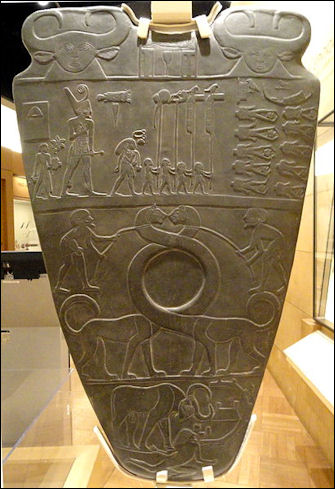
Narmer Palette 3100 BC An important part of the Oriental Institute exhibition’s allure is that it describes some of the unknowns that still intrigue archaeologists, including the birth of the alphabet. The show includes a plaque dated from 1800 B.C. that contains signs that seem to be inspired by Egyptian hieroglyphics but that are actually the earliest letters of an alphabetic script representing Semitic languages. It was found near an ancient turquoise mining site in the Sinai Peninsula, in what was part of ancient Egypt, but the men who worked there spoke the Semitic language of the Canaanites.
Because this is one of the first examples of the use of the alphabetic letters, it suggests that the alphabet was inspired by hieroglyphics. Still, no one really knows who the miners were, if they were literate or how they adapted hieroglyphics to write a western Semitic language. But in later discoveries those same forms make up parts of words.
An alphabetic language has a limited number of signs and is easier to both use and to teach than a representational system like hieroglyphics. An alphabet allows a more rapid spread of literacy and communications. Today almost all languages except Chinese and Japanese are alphabetic. The lack of an alphabet makes Chinese particularly difficult for foreigners. But if Chinese bears little similarity to languages elsewhere in the world, its origins — like the origins of hieroglyphics — have to do with the gods. Bones from ancient Chinese tombs, also on display at the Oriental, were used to help divine the future. The inscriptions on them are the earliest form of Chinese writing, and they make statements about events, such as a battle or the birth of a royal child, and also, in effect, ask how they will come out. Hot brands were put into hollows carved into turtle shells, and the configurations of the resulting cracks were interpreted as answers to important questions.
Less is known about the earliest phases and origin of Mayan writing. Much of the work under way concentrates on artifacts from the Mayans’ later period, around A.D. 600. The exhibition includes a Mayan stone monument showing the face of a dead Mayan lord. It carries his name and the date of the dedication of the stone.To Christopher E. Woods, associate professor of Sumerology at the University of Chicago and the curator of the show, it was important to include examples from all four cultures because the goal of the exhibition was “to present and describe the four times in history when writing was invented from scratch.”
History of Hieroglyphics
Proto-hieroglyphics first appeared in 3400 B.C. in the form of stick figures inscribed in stone. The origin of this ancient form of writing remains a mystery and how drawing veered towards abstraction and became hieroglyphics is also not known. Artists often played with the appearance of the figures.
Hieroglyphic-style writing predating hieroglyphics was found in present day Israel in the 1930s. Many scholars believe that alphabet (with symbols representing sounds) was invented in Canaan and was introduced to Egypt, perhaps by Hebrew slaves working in mines in Egypt.
Egyptian writing during the Old Kingdom (2686 to 2125 B.C.) was used primarily for titles, epithets and bureaucratic records. There are virtually no Old Kingdom records of history, myths, legends or everyday life. Most of these things have been surmised from interpretations of tomb paintings and hieroglyphics, and texts written as many as 2000 years later.
Demise of Hieroglyphs
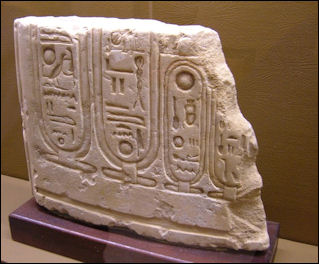
Hierogliphics The last known hieroglyphics were engraved in August 24, 394 on the Gate of Hadrian on the Nile island of Philae. Mark Millmore wrote in discoveringegypt.com: “In AD 391 the Byzantine Emperor Theodosius I closed all pagan temples throughout the empire. This action terminated a four thousand year old tradition and the message of the ancient Egyptian language was lost for 1500 years. It was not until the discovery of the Rosetta stone and the work of Jean-Francois Champollion (1790-1832) that the Ancient Egyptians awoke from their long slumber. [Source: Mark Millmore, discoveringegypt.com discoveringegypt.com]
Simon Singh of the BBC wrote: “Towards the end of the fourth century AD, within a generation, the Egyptian scripts vanished. The last datable examples of ancient Egyptian writing are found on the island of Philae, where a hieroglyphic temple inscription was carved in AD 394 and where a piece of demotic graffiti has been dated to 450 AD. The rise of Christianity was responsible for the extinction of Egyptian scripts, outlawing their use in order to eradicate any link with Egypt's pagan past. [Source: Simon Singh, BBC, February 17, 2011 |::|]
“The ancient scripts were replaced with 'Coptic', a script consisting of 24 letters from the Greek alphabet supplemented by six demotic characters used for Egyptian sounds not expressed in Greek. The ancient Egyptian language continued to be spoken, and evolved into what became known as the Coptic language, but in due course both the Coptic language and script were displaced by the spread of Arabic in the 11th century. The final linguistic link to Egypt's ancient kingdoms was then broken, and the knowledge needed to read the history of the pharaohs was lost. |::|
“In later centuries, scholars who saw the hieroglyphs tried to interpret them, but they were hindered by a false hypothesis. They assumed that hieroglyphs were nothing more than primitive picture writing, and that their decipherment relied on a literal translation of the images they saw. In fact, the hieroglyphic script and its relatives are phonetic, which is to say that the characters largely represent distinct sounds, just like the letters in the English alphabet. It would take a remarkable discovery before this would be appreciated. |::|
Purpose of Hieroglyphics
The Sumerians and Babylonians used their writing system primarily to keep records. Writing for the Egyptians took on more of religious role. Judging from the inscriptions and papyrus scrolls that have survived until today most texts dealt with spiritual matters and spells. The walls of tombs often featured more predictions of the dead's future life than records of historical events in his past life.
Hieroglyphics used in tomb paintings and religious objects were believed to be imbued with spiritual power. Many hieroglyphics were painted green because green represented youth, rebirth, spring, swamps, vegetation and resurrection. Sometimes hieroglyphic animals were depicted with disembodied heads or legs so that when they came alive in the afterworld they could not harm the pharaoh or his magic.
Hieroglyphic Alphabet, Symbols, Words and Grammar
The hieroglyphic alphabet contains 24 letters and includes: a vulture for the "A" sound; a leg for "B"; a water line for "N"; a winged seed for "I"; and an owl for "M"; a snake for "dj"; a horned viper snake for "F"; and a basket with a handle for "K." There were no hieroglyphic vowels.
The hieroglyphic language also contains determantives, which aided in specifying the meaning of words and, when grouped with other letters or symbols have a specific meaning. These include a symbol for a man, a fish, an ax and a tree. Determinatives with a phonetic sound include a walking duck (the sound "SA"), a flying duck (the sound "PA"), eye ("IR"), scarab ("KHpR") and ANKH.
Hieroglyphic texts are filled with titles and names. For example a walking duck followed by a circle with a bull’s eye means "son of [the sun god] Ra." This combination of symbols often preceded the name of a pharaoh.
Various combinations of symbols can represent objects, pronouns, possessive pronouns and question words. Some hieroglyphic letters serve as prepositions: The owl can represent "of" or "with"; the water line can represent "to" or "for." Other hieroglyphic letters can represent personal pronouns. A horned snake can be "he," "him," "his" and "it" and a basket with a handle can represent "you."

Book of the Dead
Hieroglyphic Texts
Most documents and important information was written in papyrus texts. The hieroglyphics found on tomb walls and works of art tended to be formulaic and offered little information that wasn’t already known.
Three important papyrus texts have survived to this day are: “The Pyramid Texts” , “Book of the Dead” and the “ Coffin Text”. They consisted mostly spells intended to bring about salvation and comfort the dead in the next world.
Vanessa Thorpe wrote in The Observer, “The script of a papyrus is read from one side across to the other, depending on which way round the depicted animal heads are facing. The spells and incantations appear alongside the images they evoke and they commonly deal with the sort of problems faced in life, such as the warding off of an illness. They are usually rather straightforward: prose rather than poetry. "Get back, you snake!" reads one for protection against poisonous serpents. For the ancient Egyptians, the act of simply writing something down formally, or painting it, was a way of making it true. As a result, there are no images or passages in The Book of the Dead that describe anything unpleasant happening. Setting it down would have made it part of the plan. There was, however, always a heavy emphasis on dropping the names of relevant gods at key points along the journey.[Source: Vanessa Thorpe, The Observer, October 24, 2010]
A hymn to the god Amen with a prayer for the queen, written in around 1300 B.C., goes: "Prize from the Chief Wife of the King, his beloved...Nefertiti, living, healthy, and youthful forever and ever."
Early Ancient Egyptian Religious Texts
The “Pyramid Texts” are among the oldest texts. They were based on inscriptions of spells found in the burial chambers of the pyramids and dated to around 2600 B.C. They were like an early compendium on the Egyptian religion. The “ Amduat” (“The Book of the Netherworld”) and “ The Book of the Dead “ are based on them. A typical spell from the “ Pyramid Texts “ went: “O Osiris, the King, may you be protected. I give to you all the gods, their heritages, their provisions, and all their possessions, for you have not died.”
“ The Pyramid Texts” evolved into the “ Coffin Texts” , dated to around 2000 B.C., a collection of spells placed by artisans in wooden coffins. Neither the “Pyramid Texts” nor the “ Coffin Texts” ever appeared in book form. They were written on tomb walls or coffins.
“ Amduat” (“The Book of the Netherworld”) was a narrative that described the daily journey of a dead pharaoh through the netherworld on a boat of the sun god Re, and his victory over dangers and obstacles to rise again the next morning. The book was originally restricted to use by the pharaoh and those that attended him.

Guide to the Afterlife,
Custodian forGoddess Amun
Other important texts included: 1) “The Book of Two Way” , describing the underworld as composed of canals, streams, islands, fires and boiling water; 2) “The Book of Gates” , describing the night journey of Osiris and the rewards and punishments for inhabitants of the Underworld; 3) The “ Book of That Which Is” , describing the 12 sections of the Underworld, each related to an hour of the Night; and 4) The “ Book of Adophis” , detailing the battle between the sun god Ra and the giant serpent Apophis.
Rosetta Stone
The Rosetta Stone is a black basalt slab 45 inches long and 29 inches wide. Inscribed in three languages: 53 lines of Greek, 32 lines of a cursive script now called demotic script and 16 lines of hieroglyphics. Both the demotic script and hieroglyphics were initially indecipherable. It was written by a group of priest assembled in Memphis to mark the ascension to the throne of King Ptolemy V Epiphanes in 190 B.C. and carried a Memphis decree concerning the cult of the king.
The Translation of the first half of the Greek Section of the Rosetta Stone reads: 1. In the reign of the young one who has succeeded his father in the kingship, lord of diadems, most glorious, who has established Egypt and is pious. 2. Towards the gods, triumphant over his enemies, who has restored the civilised life of men, lord of the Thirty Years Festivals [The Sed Festival, originally held at thirty-year intervals after a king’s coronation, in order to renew a king’s physical powers.], even as Hephaistos [the creator god Ptah] the Great, a king like the Sun [the sun god Ra], 3. Great king of the Upper and Lower countries [The South and North of Egypt], offspring of the Gods Philopatores, one of whom Hephaistos has approved, to whom the Sun has given victory, the living image of Zeus [name for the Egyptian god Amun], son of the Sun, Ptolemy 4. Living for ever, beloved of Ptah, in the ninth year, when Aetos son of Aetos was priest of Alexander, and the Gods Soteres, and the Gods Adelphoi, and the Gods Euergetai, and the Gods Philopatores and 5. The God Epiphanes Eucharistos; Pyrrha daughter of Philinos being Athlophoros of Berenike Euergetis; Areia daughter of Diogenes being Kanephoros of Arsinoe Philadelphos; Irene 6. Daughter of Ptolemy being Priestess of Arsinoe Philopator [Eponymous priests; priests and priestesses, always with Greek names, attached to the royal cult, who served in their office for a year and were arranged in two colleges in a completely Greek institution]; the fourth of the month of Xandikos, according to the Egyptians the 18th Mekhir. DECREE. There being assembled the Chief Priests and Prophets and those who enter the inner shrine for the robing of the
“7. Gods, and the Fan-bearers and the Sacred Scribes and all the other priests from the temples throughout the land who have come to meet the king at Memphis, for the feast of the assumption 8. By Ptolemy, the ever-living, the beloved of Ptah, the God Epiphanes Eucharistos, the kingship in which he succeeded his father, they being assembled in the temple in Memphis this day declared: 9. Whereas king Ptolemy, the ever-living, the beloved of Ptah, the god Epiphanes Eucharistos, the son of King Ptolemy and Queen Arsinoe, the Gods Philopatores, has been a benefactor both to the temples and 10. To those who dwell in them, as well as all those who are his subjects, being a god sprung from a god and goddess (like Horus the son of Isis and Osiris, who avenged his father Osiris) (and) being benevolently disposed towards
“11. The gods, has dedicated to the temples revenues in money and corn and has undertaken much outlay to bring Egypt into prosperity, and to establish the temples, 12. And has been generous with all his own means; and of the revenues and taxes levied in Egypt some he has wholly remitted and others he has lightened, in order that the people and all the others might be 13. In prosperity during his reign; and whereas he has remitted the debts to the crown being many in number which they in Egypt and in the rest of the kingdom owed; and whereas those who were
“14. In prison and those who were under accusation for a long time, he has freed of the charges against them; and whereas he has directed that the gods shall continue to enjoy the revenues of the temples and the yearly allowances given to them, both of 15. Corn and money, likewise also the revenue assigned to the gods from vine land and from gardens and the other properties which belonged to the gods in his father’s time; 16. And whereas he directed also, with regard to the priests, that they should pay no more as the tax for admission to the priesthood than what was appointed them throughout his father’s reign and until the first year of his own reign; and has relieved the members of the
“17. Priestly orders from the yearly journey to Alexandria; and whereas he has directed that impressment for the navy shall no longer be employed; and of the tax in byssus [fine linen] cloth paid by the temples to the crown he 18. Has remitted two-thirds; and whatever things were neglected in former times he has restored to their proper condition, having a care how the traditional duties shall be fittingly paid to the gods; 19. And likewise has apportioned justice to all, like Hermes (name for the Egyptian god Thoth] the great and great; and has ordained that those who return of the warrior class, and of others who were unfavourably 20. Disposed in the days of the disturbances [A reference to the years since 205 B.C., during which Upper Egypt had been ruled by two rebel native pharaohs], should, on their return be allowed to occupy their old possessions; and whereas he provided that cavalry and infantry forces and ships should be sent out against those who invaded
“21. Egypt by sea and by land, laying out great sums in money and corn in order that the temples and all those who are in the land might be in safety; and having 22. Gone to Lycopolis [A town in the ninth nome (administrative area) of the Delta, probably near Busiris but not identified with certainty] in the Busirite nome, which had been occupied and fortified against a siege with an abundant store of weapons, and all other supplies (seeing that disaffection was now of long 23. Standing among the impious men gathered into it, who had perpetrated much damage to the temples and to all the inhabitants of Egypt), and having 24. Encamped against it, he surrounded it with mounds and trenches and elaborate fortifications; when the Nile made a great rise in the eighth year (of his reign), whichusually floods the 25. Plains, he prevented it, by damming at many points the outlets of the channels (spending upon this no small amount of money), and setting cavalry and infantry to guard.”
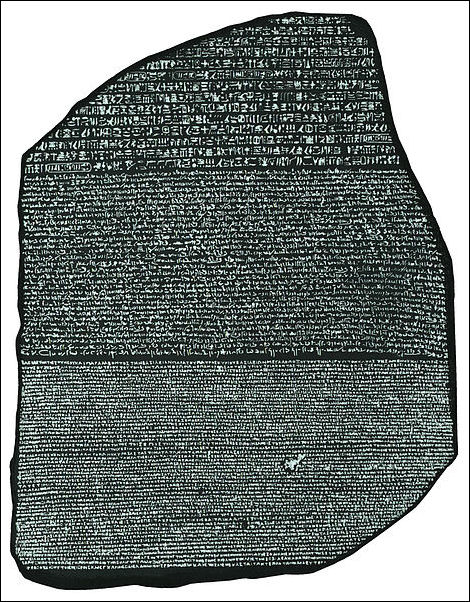
Discovery of Rosetta Stone
The Rosetta Stone was unearthed in August 1799 by French soldiers, excavating ruined Fort Rachid near the town of Rosetta at the mouth of the Nile. Around the time the stone was found France went to war with Britain. When the French were forced out Egypt the stone fell into the hands of the British and was taken to the British Museum in 1802, were it remains today. Egypt wants the Rosetta Stone back.
In 1799, after Napoleon’s invasion of Egypt the year before, a French captain named Pierre Bouchard discovered the Rosetta Stone which was carved with the same text in two languages, Egyptian and Greek, and three writing systems, hieroglyphic, demotic, and the Greek alphabet. This turned out a marvelous stroke of luck because it enabled scholars to unlock the hieroglyphic code, the basis of much our knowledge about ancient Egyptians today. [Source: Mark Millmore, discoveringegypt.com discoveringegypt.com]
Simon Singh of the BBC wrote: “In the summer of 1798, the antiquities of ancient Egypt came under particular scrutiny when Napoleon Bonaparte despatched a team of historians, scientists and draughtsmen to follow in the wake of his invading army. In 1799, these French scholars encountered the single most famous slab of stone in the history of archaeology, found by a troop of French soldiers stationed at Fort Julien in the town of Rosetta in the Nile Delta. [Source: Simon Singh, BBC, February 17, 2011. After completing a PhD in particle physics, Singh worked at the BBC.|::|]
“The soldiers were demolishing an ancient wall to clear the way for an extension to the fort, but built into the wall was a stone bearing a remarkable set of inscriptions. The same piece of text had been inscribed on the stone three times, in Greek, demotic and hieroglyphics. The Rosetta Stone, as it became known, appeared to be the equivalent of a dictionary. |::|
“However, before the French could embark on any serious research, they were forced to hand the Rosetta Stone to the British, having signed a Treaty of Capitulation. In 1802, the priceless slab of rock-118cm (about 46 ½ in) high, 77cm (about 30in) wide and 30cm (about 12in) deep, and weighing three quarters of a tonne-took up residence at the British Museum, where it has remained ever since. |::| “The translation of the Greek soon revealed that the Rosetta Stone contained a decree from the general council of Egyptian priests issued in 196 B.C. Assuming that the other two scripts contained the identical text, then it might appear that the Stone could be used to crack hieroglyphs. |::|
“However, a significant hurdle remained. The Greek revealed what the hieroglyphs meant, but nobody had spoken the ancient Egyptian language for at least eight centuries, so it was impossible to establish the sound of the Egyptian words. Unless scholars knew how the Egyptian words were spoken, they could not deduce the phonetics of the hieroglyphs. |::|
Deciphering the Rosetta Stone
Hieroglyphics in their developed form were phonetic symbols not merely pictures. The first man in modern history to realize this was a German mathematician named Athanasius Kircher (1602-1680) who discovered that hieroglyphics were an early form of the Coptic language. Up until his discovery it was thought that the hieroglyphics were symbols of ideas and objects not the phonetic symbols that they really were.
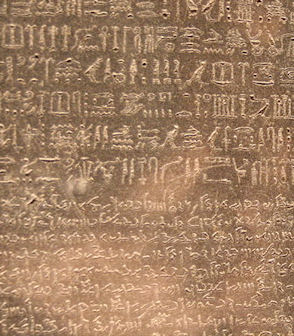
Rossetta text The Frenchmen Jean-Françious Champollion (1790-1832) is given credit with the deciphering the hieroglyphics using the Greek on the Rosetta Stone. Champollion became aware of the Rosetta Stone when he was 12 and, the story goes, he became obsessed with deciphering it. Before he reached the age of 20 he had mastered Arabic, Syriac, Hebrew, Latin and Coptic (a language related to ancient Egyptian).
Champollion was given clues by Dr. Thomas Young, a British scholar who theorized the hieroglyphics were phonetic and had an alphabetical base using a bilingual-Greek-hieroglyphic text on an obelisk in Philae, Egypt. He found that seven elongated ovals or cartouches spelled something phonetically — the name of Ptolemy and also found the name of Cleopatra.
The proper names of Ptolemy, Cleopatra and Ramses gave Champollion the necessary clues to crack the ancient Egyptian written language. Using his knowledge of Coptic, Champollion went much further than Young and devised a complete system of decipherment rules and basic grammar. He realized that hieroglyphic language was alphabetic in principal but included pictorial signs representing complete words and other signs, when attached to words, represented the word’s category (e.g. "an animal name").
The stress of the intensive work is believed to have contributed to Champollion's death from a stroke at the age of 42. The genius of his work wasn't fully appreciated until 30 years later. After his death German scholars figured the full complexity of the hieroglyphics and gave accurate translations for texts misunderstood by Champollion. Today hieroglyphics can be read about as well as the writing for most languages.
Thomas Young and the Decipherment of the Rosetta Stone
Simon Singh of the BBC wrote: “When the English polymath Thomas Young heard about the Rosetta Stone, he considered it an irresistible challenge. In 1814 he went on his annual holiday to Worthing and took with him a copy of the Rosetta Stone inscriptions. Young's breakthrough came when he focussed on a set of hieroglyphs surrounded by a loop, called a cartouche. He suspected that these highlighted hieroglyphs represented something of significance, possibly the name of the Pharaoh Ptolemy, who was mentioned in the Greek text. [Source: Simon Singh, BBC, February 17, 2011 |::|]
“If this were the case, it would enable Young to latch on to the phonetics of the corresponding hieroglyphs, because a pharaoh's name would be pronounced roughly the same regardless of the language. Young matched up the letters of Ptolemy with the hieroglyphs, and he managed to correlate most of the hieroglyphs with their correct phonetic values. The decipherment of the Egyptian script was underway. He repeated his strategy on another cartouche, which he suspected contained the name of the Ptolemaic queen Berenika, and identified the sound of further hieroglyphs. |::|
“Young was on the right track, but his work suddenly ground to a halt. It seems that he had been brainwashed by the established view that the script was picture writing, and he was not prepared to shatter that paradigm. He excused his own phonetic discoveries by noting that the Ptolemaic dynasty was not of Egyptian descent, and hypothesised that their foreign names would have to be spelt out phonetically because there would not be a symbol within the standard list of hieroglyphs. |::|
“Young called his achievements 'the amusement of a few leisure hours.' He lost interest in hieroglyphics, and brought his work to a conclusion by summarising it in an article for the 1819 supplement to the Encyclopaedia Britannica.” |::|
Jean-François Champollion and the Decipherment of the Rosetta Stone
Jean-François Champollion was a historian and brilliant linguist. By the age of 16 he was fluent in Latin and Greek and six ancient languages, including Coptic, derived from ancient Egyptian. Because he understood Coptic he was able to translate the meanings of the ancient Egyptian words and crack the hieroglyphic code. In the 1820s, Champollion compiled a long list Egyptian symbols with their Greek equivalents and figured out that hieroglyphics were not only alphabetic but syllabic, and in some cases determinative, meaning that they depicted the meaning of the word itself. [Source: Mark Millmore, discoveringegypt.com discoveringegypt.com]
Simon Singh of the BBC wrote: “Jean-François Champollion's obsession with hieroglyphs began around 1801 when, as a ten-year-old, he saw a collection of Egyptian antiquities, decorated with bizarre inscriptions. He was told that nobody could interpret this cryptic writing, whereupon the boy promised that he would one day solve the mystery. [Source: Simon Singh, BBC, February 17, 2011 |::|]
“Champollion applied Young's technique to other cartouches, but the names, such as Alexander and Cleopatra, were still foreign, supporting the theory that phonetics was only invoked for words outside the traditional Egyptian lexicon. Then, in 1822, Champollion received some cartouches that were old enough to contain traditional Egyptian names, and yet they were still spelt out, clear evidence against the theory that spelling was only used for foreign names. |::|
Champollion focussed on a cartouche containing just four hieroglyphs: the first two symbols were unknown, but the repeated pair at the end signified 's-s'. This meant that the cartouche represented ('?-?-s-s'). At this point, Champollion brought to bear his vast linguistic knowledge. Although Coptic, the descendant of the ancient Egyptian language, had ceased to be a living language, it still existed in a fossilised form in the liturgy of the Christian Coptic Church. Champollion had learnt Coptic as a teenager, and was so fluent that he used it to record entries in his journal. However, he had not previously considered that Coptic might also be the language of hieroglyphs. |::|
“Champollion wondered if the first hieroglyph in the cartouche, the disc, might represent the sun, and then he assumed its sound value to be that of the Coptic word for sun, 'ra'. This gave him the sequence ('ra-?-s-s'). Only one pharaonic name seemed to fit. Allowing for the omission of vowels and the unknown letter, surely this was Rameses. The spell was broken. Hieroglyphs were phonetic and the underlying language was Egyptian. Champollion dashed into his brother's office where he proclaimed 'Je tiens l'affaire!' ('I've got it!') and promptly collapsed. He was bedridden for the next five days.” |::|
Cracking the Code of the Rosetta Stone
Simon Singh of the BBC wrote: “Although this was just one more cartouche, it clearly demonstrated the fundamental principles of hieroglyphics. It showed that the scribes sometimes exploited the rebus principle, which involves breaking long words into phonetic components, and then using pictures to represent these components. For example, the word belief can be broken down into two syllables, 'bee-leaf'. Hence, instead of writing the word alphabetically, it could be represented by the image of a bee and a leaf. In the Rameses example, only the first syllable ('ra') is represented by a rebus image, a picture of the sun, while the remainder of the word is spelt more conventionally. [Source: Simon Singh, BBC, February 17, 2011 |::|]
“The significance of the sun in the Rameses cartouche is enormous, because it indicates the language of the scribes. They could not have spoken English, because this would mean that the cartouche would be pronounced 'Sun-meses'. Similarly, they could not have spoken French, because then the cartouche would be pronounced 'Soleil-meses'. The cartouche only makes sense if the scribes spoke Coptic, because it would then be pronounced 'Ra-meses'. |::|
“Champollion went on to show that for most of their writing, the scribes relied on using a relatively conventional phonetic alphabet. Indeed, Champollion called phonetics the 'soul' of hieroglyphics. Using his deep knowledge of Coptic, Champollion began a prolific decipherment of hieroglyphs. He identified phonetic values for the majority of hieroglyphs, and discovered that some of them represented combinations of two or even three consonants. This sometimes gave scribes the option of spelling a word using several simple hieroglyphs or with just one multi-consonantal hieroglyph. |::|
“In July 1828, Champollion embarked on his first expedition to Egypt. Thirty years earlier, Napoleon's expedition had made wild guesses as to the meaning of the hieroglyphs that adorned the temples, but now Champollion could reinterpret them correctly. His visit came just in time. Three years later, having written up the notes, drawings and translations from his Egyptian expedition, he suffered a severe stroke. He died on 4th March 1832, aged 41, having achieved his childhood dream.” |::|
Image Sources: Wikimedia Commons, The Louvre, The British Museum, The Egyptian Museum in Cairo
Text Sources: UCLA Encyclopedia of Egyptology, escholarship.org ; Internet Ancient History Sourcebook: Egypt sourcebooks.fordham.edu ; Tour Egypt, Minnesota State University, Mankato, ethanholman.com; Mark Millmore, discoveringegypt.com discoveringegypt.com; Metropolitan Museum of Art, National Geographic, Smithsonian magazine, New York Times, Washington Post, Los Angeles Times, Discover magazine, Times of London, Natural History magazine, Archaeology magazine, The New Yorker, BBC, Encyclopædia Britannica, Time, Newsweek, Wikipedia, Reuters, Associated Press, The Guardian, AFP, Lonely Planet Guides, “World Religions” edited by Geoffrey Parrinder (Facts on File Publications, New York); “History of Warfare” by John Keegan (Vintage Books); “History of Art” by H.W. Janson Prentice Hall, Englewood Cliffs, N.J.), Compton’s Encyclopedia and various books and other publications.
Last updated September 2018
